Can London's rivers be swimmable within 10 years?
 BBC
BBCAt 40 miles (64km) long, the River Roding is London's third largest river. From its source near Stansted airport, it snakes through Essex and the east of the capital, eventually ending up in the Thames.
It is one of those rivers in the capital earmarked by the Mayor of London Sir Sadiq Khan as potentially clean enough to swim in as part of his plan to "to make rivers in London swimmable within 10 years".
If he is to fulfil that promise, the Roding needs cleaning up.
So what are the challenges facing this type of river to make them swimmable? And what lessons can be learned from the discoveries made on the Roding?
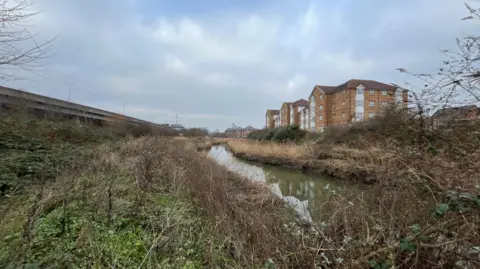
The River Roding is surrounded by housing, industrial sites and crossed by the M25, North Circular Road and various train lines including the District line. It doesn't though have the dangerous currents or traffic of the Thames so feasibly could be a swimming spot.
However while the river has a serene beauty passing through this industrial landscape, on a cold January day, the thought of it being a swimming spot within 10 years seems a bit fanciful.
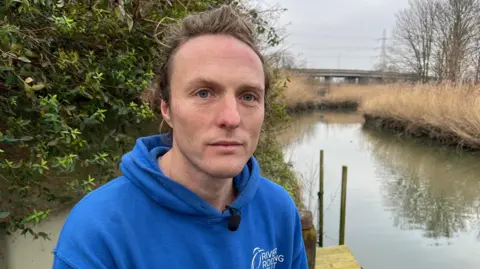
Paul Powlesland from The River Roding Trust, believes with interventions you could make the Roding swimmable but there are many significant challenges.
He knows the river well.
"I already swim in this river when it hasn't rained too much and the water quality is better and it's really lovely. It isn't impossible but it is a formidable challenge but it is solvable."
"What we need is information to identify the problems, where pollution is entering the river and then real action to tackle that."
Poor water quality
A big issue is sewage.
Paul shows us a surface water outfall that is also illegally dumping sewage straight into the Roding. It is disgusting and alarming. Wet wipes and toilet roll have caught on the grill.
Paul says the outflow was only discovered by the River Trust and Thames Water didn't know about it.
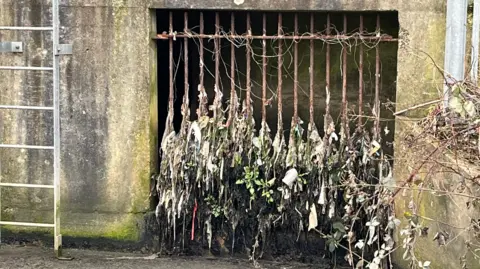
He says there are dozens more that are unidentified, and hundreds if not thousands across the capital that no-one has mapped.
"We are trying to map where these outfalls are and then we need concerted action by Thames Water to fix them. Not in 30 or 40 years but in five years.
"And if Thames Water doesn't do that then we need politicians like the mayor to force them to do it."
A recent survey by the environmental charity Thames21 and The River Roding Trust found untreated sewage discharges and unpermitted outfalls have caused dangerously high levels of bacteria to be found at multiple sites across a nine-mile (14.5km) stretch of the River Roding.
Citizen scientists between 15 May and 30 September 2024 found that samples they took at seven sites failed to meet sufficient bathing water regulation standards for safe swimming for both E. coli and Intestinal Enterococci.
Road runoff pollution
While sewage eventually biodegrades, the same cannot be said for road runoff a toxic mix of chemicals, oil, tyre wear and plastics that comes from motor vehicles.
At a recent hearing of the London Assembly Environment Committee, the Thames21 charity outlined how road runoff could be the biggest issue for the capital's rivers.
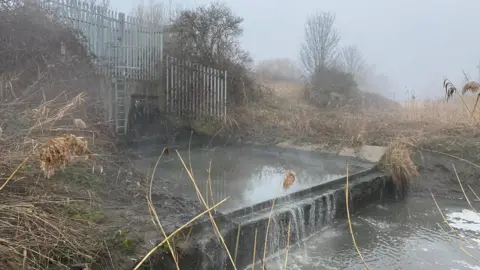 River Roding Trust
River Roding TrustJohn Bryden from Thames 21 said one section of the Pymmes Brook in Enfield, in north London is so heavily polluted by runoff that only leeches can survive there.
He said: "That's where we need to be getting into the detail and putting solutions in upstream so that pollution is held and treated in those wetlands and then we can remove that contamination."
The Roding is surrounded by heavily used roads like the North Circular. When it rains, the road runoff floods the river.
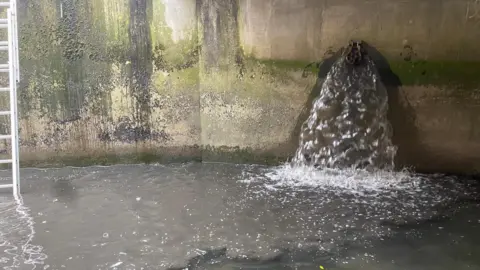 River Roding Trust
River Roding TrustPaul Powlesland from The Roding Trust also thinks the mayor should persuade Transport for London (TfL) and the councils to do much more to catch the runoff before it gets to the river.
"Road runoff is a big issue on the Roding. From when the river comes into London it's next to motorways all the way down to the Thames," said Mr Bryden.
"All of the heavy metals, oil, pollutants, forever chemicals go straight from the road into the river.
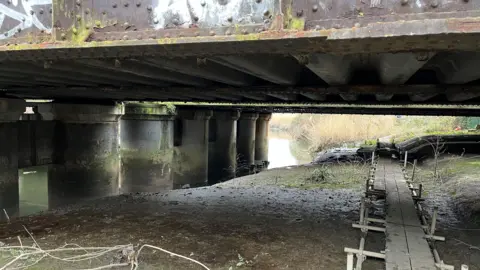
"In the long term that might even worse than sewage - at least sewage degrades - a lot of these chemicals just sit in the silt and will have to be remediated.
"We need every single road outfall to be located, mapped and a solution put in place."
Rubbish and access
There are handful of sites used for swimming on the Thames in west London like beyond Teddington lock where it is non-tidal.
But it isn't permitted to swim in the tidal Thames where there are strong currents and it is a busy shipping lane.
Any swimming in the Thames east of Putney Bridge is completely prohibited.
On the Roding, land is owned by TfL and the local council and the Mayor's Office for Policing and Crime.
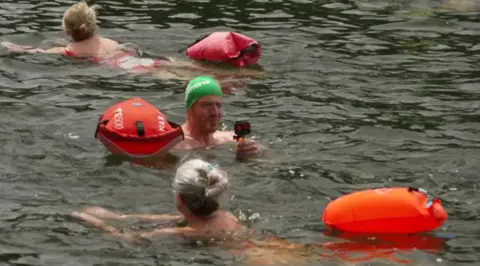
Getting access for the trust to carry out environmental work on some of the land has been time consuming. The trust wants a review of all public land to see how it can be used for swimming and public access.
On the Roding, there is still a lot of rubbish even though the local charity carries out litter picks. There is a lot of fly tipping.
The charity suggests the mayor could turbocharge the work of volunteers with extra funding.
 River Roding Trust
River Roding TrustJohn Bryden is from the river charity Thames 21.
He recently told the London Assembly members: "There needs to be a robust monitoring approach which includes citizen scientists and community organisations and charities and academics.
"And that data needs to be integrated with Thames Water so it informs what happens and that holds organisations to account."
"That monitoring also needs to identify the solution. We see lots of monitoring reports written and then forgotten. We need translate that into action."
To clean up a river could come at a cost of between £5m and £20m but it could be much, much more.
Thames21 thinks a blended approach to that funding including corporate sponsors is the best approach but any improvements would not be cheap.
A spokesperson for the Mayor of London said: "The mayor is producing a bold plan for cleaning up and protecting rivers in the capital so that Londoners can safely enjoy the benefits of nature – including swimming where safe to do so.
"However, he knows the scale of the challenge means it will take the bringing together of many different organisations.
"Sadiq is proud to have provided funding to make the Roding accessible to more Londoners, and will continue working to open up access to our waterways, to increase nature in them and to make them cleaner.
"He will also hold the regulators and utilities to account – addressing not just sewage discharge, but missed connections and road run off."
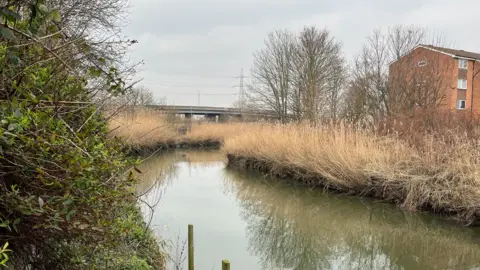
A spokesperson for Thames Water said: "As our infrastructure ages, and our population grows, more investment will be required.
"The Thames Tideway Tunnel, a £4.5bn investment, is nearing completion.
"This project, combined with previous upgrades we've made to our London sewage works and the building of the Lee Tunnel, will capture 95% of the volume of untreated sewage currently entering the tidal Thames in a typical year.
"We have published plans to upgrade over 250 of our sewage treatment works and sewers to treat the high volumes of incoming sewage and reduce the need for overflows during wet weather.
"In London, we're spending £145m upgrading Beckton sewage works."
Listen to the best of BBC Radio London on Sounds and follow BBC London on Facebook, X and Instagram. Send your story ideas to [email protected]
